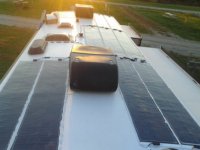Silverado23
Iowa Chapter Leaders
So after much planning and many questions, I finally have my solar installation underway.
I have the panels installed and am working on routing the cables from roof to controller to batteries.
I've got the locations figured out and the conduit installed from the roof to the controller, Now the issue is routing from the controller to the batteries.
I have tried to avoid drilling holes and so far only needed one to get the conduit from the roof to the controller and hole was behind the refrigerator.
The issue I am having is I need to try to keep the cables short from the controller to the batteries and was attempting to use existing holes but the one in the floor adds an extra 4 feet to the route and may be blocked by the fresh water tank.
I figure I can drill through the floor as there is nothing directly under the floor in the underbelly where I want to drill. The contruction of the floor is a foam and OSB laminated with Aluminum frame. Are there hidden crossbeams in the floor (not the trusses in the underbelly) , How would be the best (easiest) way to find the location of these crossbeams so I can avoid drilling into them?
I have the panels installed and am working on routing the cables from roof to controller to batteries.
I've got the locations figured out and the conduit installed from the roof to the controller, Now the issue is routing from the controller to the batteries.
I have tried to avoid drilling holes and so far only needed one to get the conduit from the roof to the controller and hole was behind the refrigerator.
The issue I am having is I need to try to keep the cables short from the controller to the batteries and was attempting to use existing holes but the one in the floor adds an extra 4 feet to the route and may be blocked by the fresh water tank.
I figure I can drill through the floor as there is nothing directly under the floor in the underbelly where I want to drill. The contruction of the floor is a foam and OSB laminated with Aluminum frame. Are there hidden crossbeams in the floor (not the trusses in the underbelly) , How would be the best (easiest) way to find the location of these crossbeams so I can avoid drilling into them?

